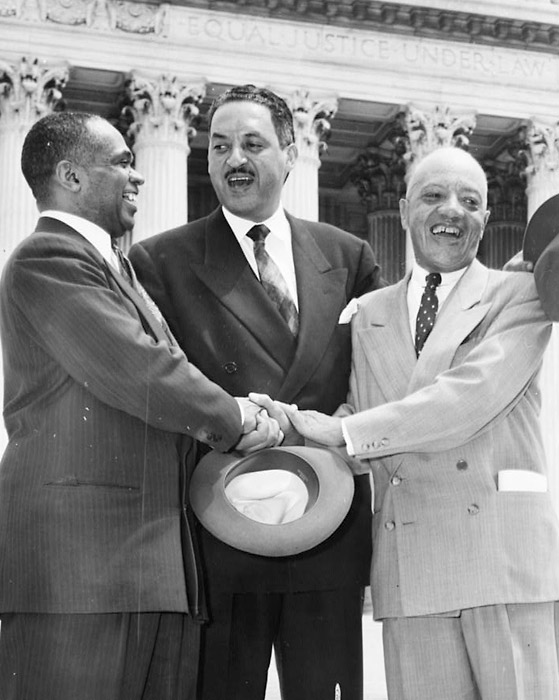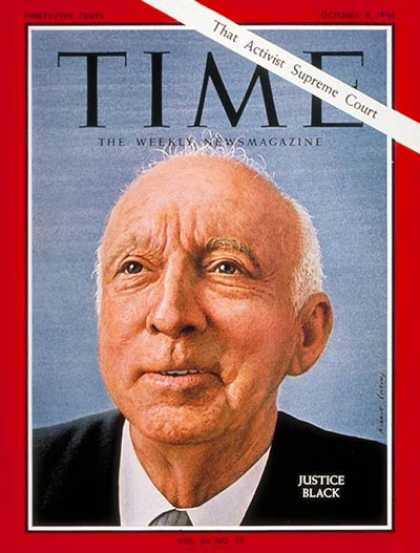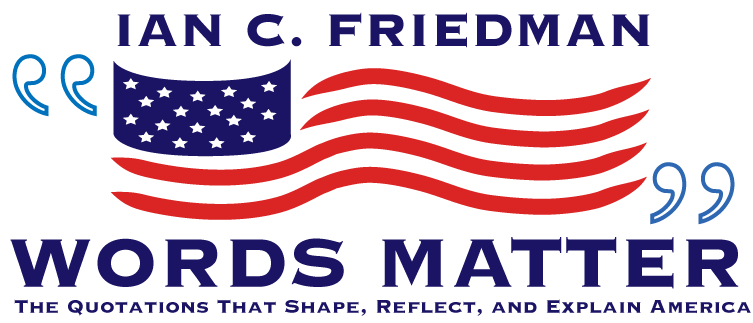“Separate educational facilities are inherently unequal.” – Earl Warren, May 17, 1954
The landmark U.S. Supreme Court decision that prohibited segregation in public education, Brown v. Board of Education, was delivered fifty-six years ago today.
The case has appropriately assumed its place as among the most significant in the history of the United States. It also provided an early indication of the enormous impact on American society that would be made by Earl Warren, who had been Chief Justice of the Supreme Court for less than a year when he led the court on Brown.
 Earl Warren–the last Supreme Court justice born in the 19th century–was born on March 19, 1891 in Los Angeles. Warren was the son of Scandanavian immigrants–the family’s name had been changed from Varran–and he grew up in Bakersfield, California. He earned his undergraduate and law degrees from the University of California at Berkeley before beginning a remarkable legal and political career. Warren was a district attorney before being elected as California’s attorney general. From 1933-43, Warren was the governor of California, the only person ever elected to that post three times. Enjoying a reputation for decency and integrity he would maintain throughout his carrer, Warren suffered his only electoral loss in 1948, when he was the vice presidential candidate running on the Republican ticket with Thomas Dewey that lost to President Harry Truman.
Earl Warren–the last Supreme Court justice born in the 19th century–was born on March 19, 1891 in Los Angeles. Warren was the son of Scandanavian immigrants–the family’s name had been changed from Varran–and he grew up in Bakersfield, California. He earned his undergraduate and law degrees from the University of California at Berkeley before beginning a remarkable legal and political career. Warren was a district attorney before being elected as California’s attorney general. From 1933-43, Warren was the governor of California, the only person ever elected to that post three times. Enjoying a reputation for decency and integrity he would maintain throughout his carrer, Warren suffered his only electoral loss in 1948, when he was the vice presidential candidate running on the Republican ticket with Thomas Dewey that lost to President Harry Truman.
Warren was appointed as Chief Justice of the U.S. Supreme Court by President Dwight Eisenhower in October 1953. Warren was praised by Eisenhower as, “represent[ing] the kind of political, economic, and social thinking that I believe we need on the Supreme Court.” After the sixteen-year era of what became known as The Warren Court had significantly strengthened individual rights-including those of the accused–and limited the scope of government power on restricting civil liberties, Eisenhower quipped that appointing Warren was, ” the most damned-fool mistake I ever made.”
Warren’s influence on Brown was profound, not only because he was Chief Justice, but because of his strategic desire that the court’s decision be an unequivocal rejection of the “separate but equal” doctrine established by the 1896 Supreme Court decision in Plessy v. Ferguson. Because of what he viewed as the case’s enormous moral, social, and historical importance–and his belief that any dissent by the court would provide an enduring defense for segregationists–Warren applied his copious political skill and effectiveness at developing personal relationships to prevail upon his relatively new Supreme Court colleagues to make this a unanimous decision, lacking even concurring opinions.
Following Warren’s directive that the written opinions “…should be short, readable by the lay public, non-rhetorical, unemotional and, above all, non-accusatory”, the Court expressed in unusually clear terms:
Segregation of white and colored children in public schools has a detrimental effect upon the colored children. The impact is greater when it has the sanction of the law, for the policy of separating the races is usually interpreted as denoting the inferiority of the negro group. A sense of inferiority affects the motivation of a child to learn. Segregation with the sanction of law, therefore, has a tendency to [retard] the educational and mental development of negro children and to deprive them of some of the benefits they would receive in a racial[ly] integrated school system.
Whatever may have been the extent of psychological knowledge at the time of Plessy v. Ferguson, this finding is amply supported by modern authority. Any language in Plessy v. Ferguson contrary to this finding is rejected.
We conclude that, in the field of public education, the doctrine of “separate but equal” has no place. Separate educational facilities are inherently unequal. Therefore, we hold that the plaintiffs and others similarly situated for whom the actions have been brought are, by reason of the segregation complained of, deprived of the equal protection of the laws guaranteed by the Fourteenth Amendment. This disposition makes unnecessary any discussion whether such segregation also violates the Due Process Clause of the Fourteenth Amendment…
Two other interesting and related notes to this momentous Supreme Court decision; one timely and the other witty.
 * The lead counsel for the plaintiff in the Brown case was Thurgood Marshall (pictured with victorious Brown legal team at center), a young Maryland lawyer and the great-grandson of a slave. Selected as the first African American to serve on the U.S. Supreme Court by President Lyndon Johnson in 1967, Marshall would serve as an associate justice for 24 years. Among his many clerks during this tenure on the Supreme Court was Elena Kagan, who was picked by President Obama earlier this month to fill the vacancy created by the upcoming retirement of Justice John Paul Stevens. Before Obama selected her, Kagan served as the U.S. Solicitor General, as Marshall had from 1965-67.
* The lead counsel for the plaintiff in the Brown case was Thurgood Marshall (pictured with victorious Brown legal team at center), a young Maryland lawyer and the great-grandson of a slave. Selected as the first African American to serve on the U.S. Supreme Court by President Lyndon Johnson in 1967, Marshall would serve as an associate justice for 24 years. Among his many clerks during this tenure on the Supreme Court was Elena Kagan, who was picked by President Obama earlier this month to fill the vacancy created by the upcoming retirement of Justice John Paul Stevens. Before Obama selected her, Kagan served as the U.S. Solicitor General, as Marshall had from 1965-67.
 * Among the strongest supporters of the Supreme Court’s decision to outlaw racial segregation in public education in Brown was Justice Hugo Black, an Alabama native who had joined the Ku Klux Klan in the 1920s in an attempt to increase his electoral prospects for a U.S. Senate race, which he later won at the age of 40. Black had dropped out of the Klan prior to his arrival in the Senate, several years before being appointed in 1937 as the first of what eventually became eight Supreme Court justices picked by President Franklin Roosevelt. During his 34 years on the court Black became one of the most forceful advocates of decisions that struck down various forms of racial discrimination. Late in his life, Black’s daughter said of him, “My father used to wear white robes and scare black people. Now he wears black robes and scares white people.”
* Among the strongest supporters of the Supreme Court’s decision to outlaw racial segregation in public education in Brown was Justice Hugo Black, an Alabama native who had joined the Ku Klux Klan in the 1920s in an attempt to increase his electoral prospects for a U.S. Senate race, which he later won at the age of 40. Black had dropped out of the Klan prior to his arrival in the Senate, several years before being appointed in 1937 as the first of what eventually became eight Supreme Court justices picked by President Franklin Roosevelt. During his 34 years on the court Black became one of the most forceful advocates of decisions that struck down various forms of racial discrimination. Late in his life, Black’s daughter said of him, “My father used to wear white robes and scare black people. Now he wears black robes and scares white people.”
9 Responses to ““Separate educational facilities are inherently unequal.” – Earl Warren, May 17, 1954”
Pingback from A Timeline of American Education by Dr. Jay | drjaysacademy
Time October 20, 2016 at 2:02 pm
[…] Court announces its decision in the case of Brown v. Board. of Education of Topeka, ruling that “separate educational facilities are inherently unequal,” thus overturning its previous ruling in the 1896 case of Plessy v. Ferguson. Brown v. Board of […]
Pingback from ANALYSIS: Will Netanyahu risk exposing one of Israel’s secrets? | Tegenwicht Platform
Time October 30, 2017 at 8:36 am
[…] a citizen is Jewish or not. In the United States during the mid-1950s, the Supreme Court ruled in a landmark decision amid the civil rights struggle that “separate is inherently unequal” – and so it has […]
Pingback from ¿Se arriesgará Netanyahu a exponer el secreto más feo de Israel? – Periódico Alternativo
Time November 1, 2017 at 2:05 am
[…] mediados de la d é cada de 1950, en medio de la lucha por los derechos civiles, la Corte Suprema dictaminó en una decisión histórica que “separar es intrínsecamente desigual” y así se ha […]
Pingback from Netanyahou prendra-t-il le risque de révéler l’un des plus vils secrets d’Israël ? – Jonathan Cook’s picture | Réseau International
Time November 2, 2017 at 1:02 am
[…] est juif ou non. Aux États-Unis, au milieu des années 1950, la Cour suprême a statué dans une décision qui a fait jurisprudence dans le cadre de la lutte pour les droits civiques que « séparer est intrinsèquement […]
Pingback from Netanyahou prendra-t-il le risque de révéler l’un des plus vils secrets d’Israël ? | Groupe Gaulliste Sceaux
Time November 2, 2017 at 1:19 am
[…] est juif ou non. Aux États-Unis, au milieu des années 1950, la Cour suprême a statué dans une décision qui a fait jurisprudence dans le cadre de la lutte pour les droits civiques que « séparer est intrinsèquement […]
Pingback from Netanyahou prendra-t-il le risque de révéler l’un des plus vils secrets d’Israël ? – Le Monde…
Time November 2, 2017 at 3:28 am
[…] est juif ou non. Aux États-Unis, au milieu des années 1950, la Cour suprême a statué dans une décision qui a fait jurisprudence dans le cadre de la lutte pour les droits civiques que « séparer est intrinsèquement […]
Pingback from ¿Se arriesgará Netanyahu a exponer el secreto más feo de Israel? | PRENSAISLAMICA.COM
Time November 3, 2017 at 6:34 am
[…] mediados de la d é cada de 1950, en medio de la lucha por los derechos civiles, la Corte Suprema dictaminó en una decisión histórica que “separar es intrínsecamente desigual” y así se ha […]
Pingback from Civil Rights Movement – HIST281 Group 1
Time April 26, 2018 at 8:25 pm
[…] race because they are not allowed into white schools. This lead to the court’s decision of “Separate educational facilities are inherently unequal” and led to the desegregation of schools in the united states over the next few […]





Pingback from History of Education – Technology and Future of Education
Time March 6, 2016 at 9:39 am
[…] Court announces its decision in the case of Brown v. Board. of Education of Topeka, ruling that “separate educational facilities are inherently unequal,” thus overturning its previous ruling in the 1896 case of Plessy v. Ferguson. Brown v. Board of […]